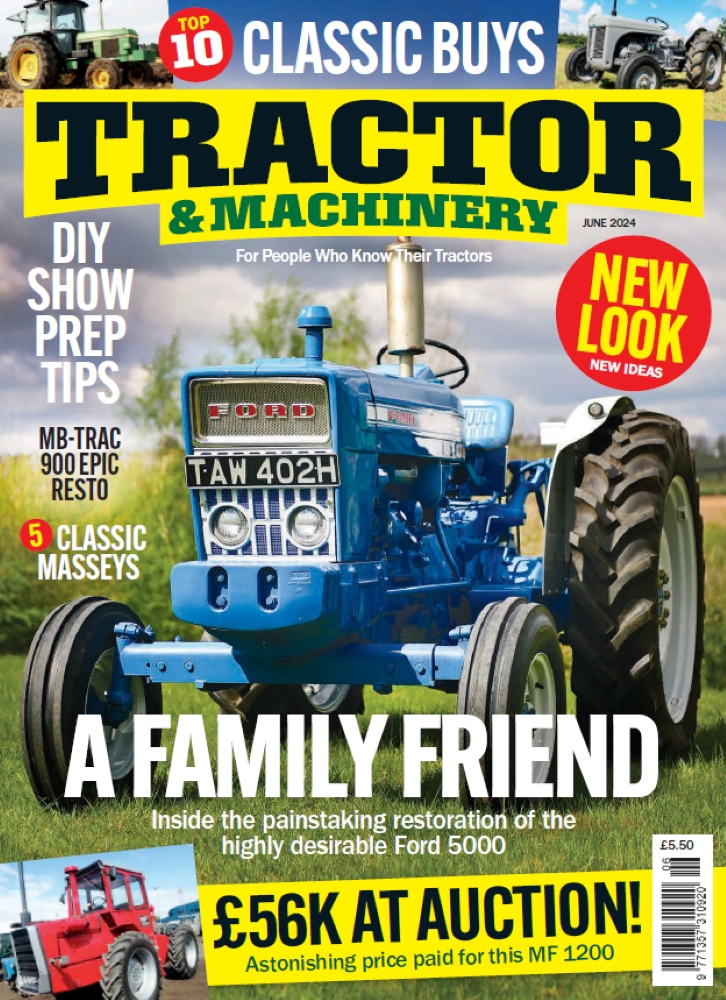Extremely rare 1944 Bedford OWL superbly restored
Posted by Chris Graham on 23rd September 2024
Zack Stiling reports on the restoration of an extremely rare 1944 Bedford OWL, which was a wartime lorry produced for civilian operators.
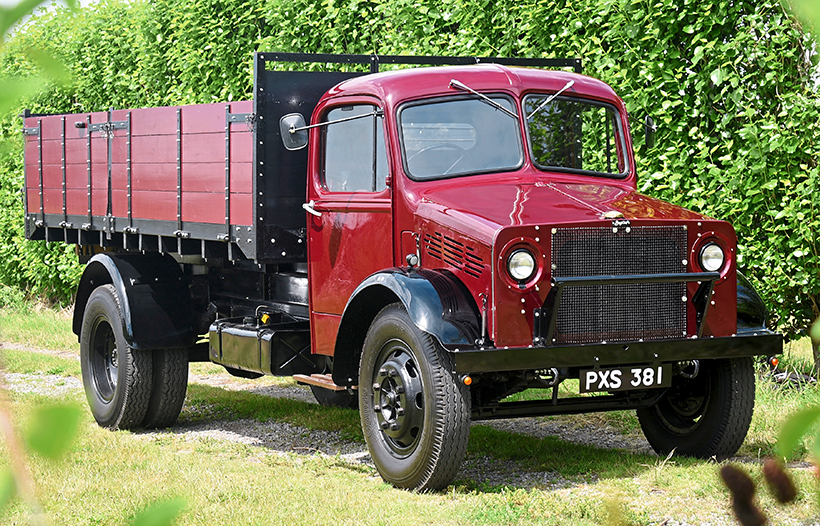
Bedford OWL: Despite its snub-nosed front, the Bedford is a very handsome sight now it’s been restored.
It’s not unusual for people to regard affectionately vehicles that played a significant part in their early lives, such as their first car, cars their father owned, or the car they learned to drive in. Indeed, it’s quite a natural thing for a person, later in life, to want to track down and preserve just such a car. Bill Thorburn had a slightly more difficult task to source the vehicle that put him on the road, because it was a lorry – a wartime Bedford O-type, to be precise – and survivors are not the easiest vehicles to find or restore.
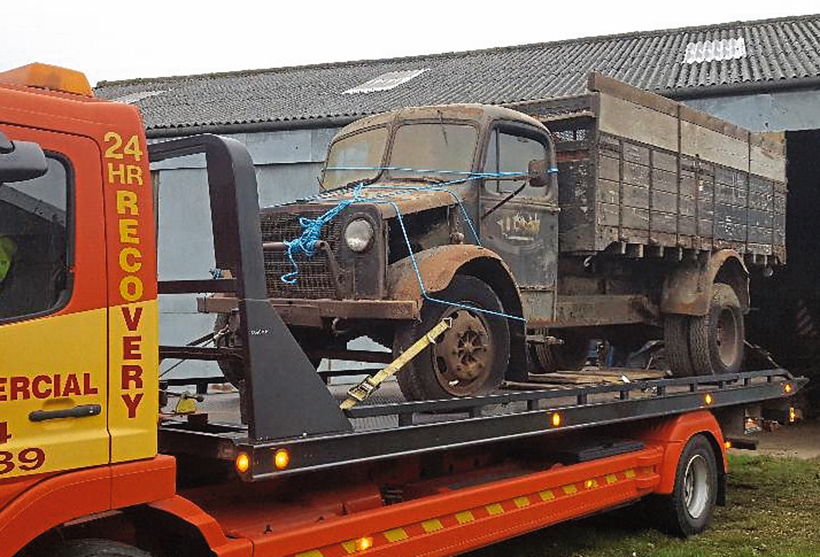
The Bedford as recovered, still with traces of its original brewery sign-writing.
“I passed my test in a 5-ton O-type when I was 17,” Bill recalls. “It was a way of getting a licence. I’d already failed my test for going too slowly in a car, so I thought ‘They won’t catch me next time – I’ll do it in a lorry.’ It was my father’s. He had a farm in East Lothian.” That particular O-type was an ex-Navy example with a dropside body. “It was like new when my father bought it.”
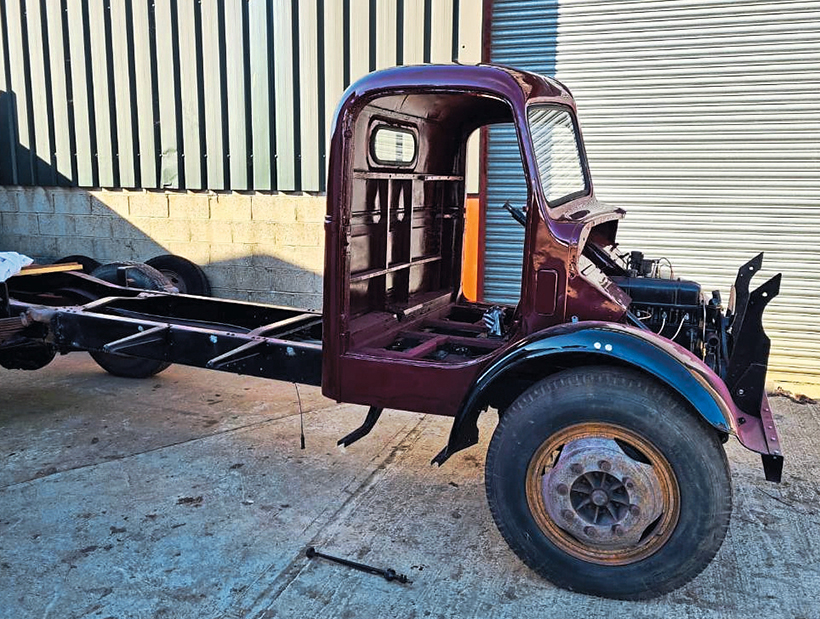
Angelo Esposito, a skilled young metalworker, was worked hard to revive the rotten cab.
As time moved on, Bill started to buy and restore historic cars and tractors, but commercial vehicles didn’t come back onto his radar until the late 1990s, when he bought and restored a 1944 Bedford OXC tractor unit, which he bought in pieces. Working as a construction plant fitter, he is no stranger to heavy machinery and the OXC was duly restored. It remains a familiar sight today at south-eastern rallies in its Ford Imperial Maroon, a colour so chosen as Bill had fond memories of an Anglia in the same colour which served as his family car in the 1960s.
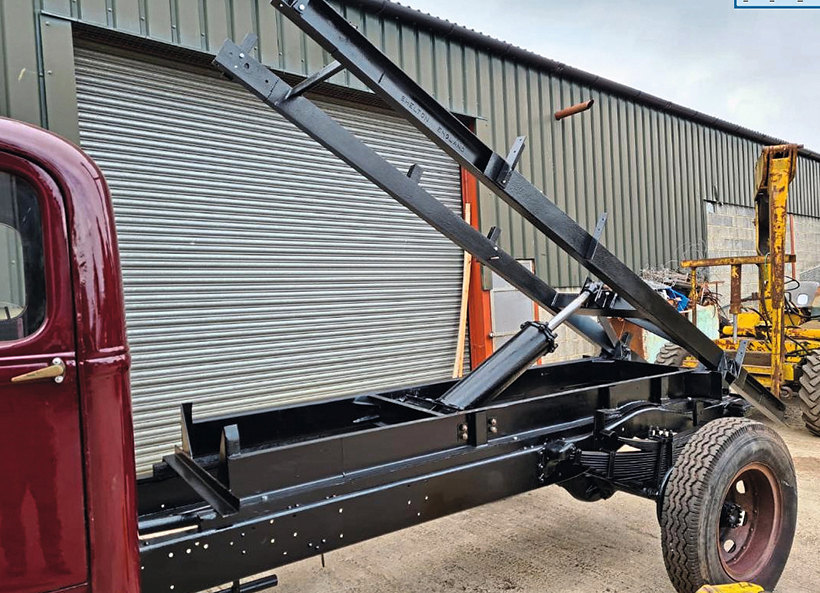
The chassis, at least, had been well-preserved, thanks to being soaked in spilt diesel.
Moving on 20 years, to November 2019, the next project, a 1944 Bedford OWL, appears on the scene. Despite its model designation – ‘O-type, wartime, long-chassis’ – the OWL was not a military vehicle. The first O-types arrived as part of an all-new range, with the 30cwt K- and 2-ton M-types, in the summer of 1939, notably the first Bedford lorries with pressed-steel cabs. Within a few months, most existing O-types were being compulsorily purchased from their operators for military use, and before long the production lines at Luton were devoted to the fulfilment of wartime Government contracts. This resulted in the development of various new OX and OY models to military specification, hallmarks of which included heavy-duty wheels, twelve-volt electrics, utilitarian snub-nosed bonnets instead of the friendly ‘bullnose’, and Solex carburetters in place of the usual Zeniths.
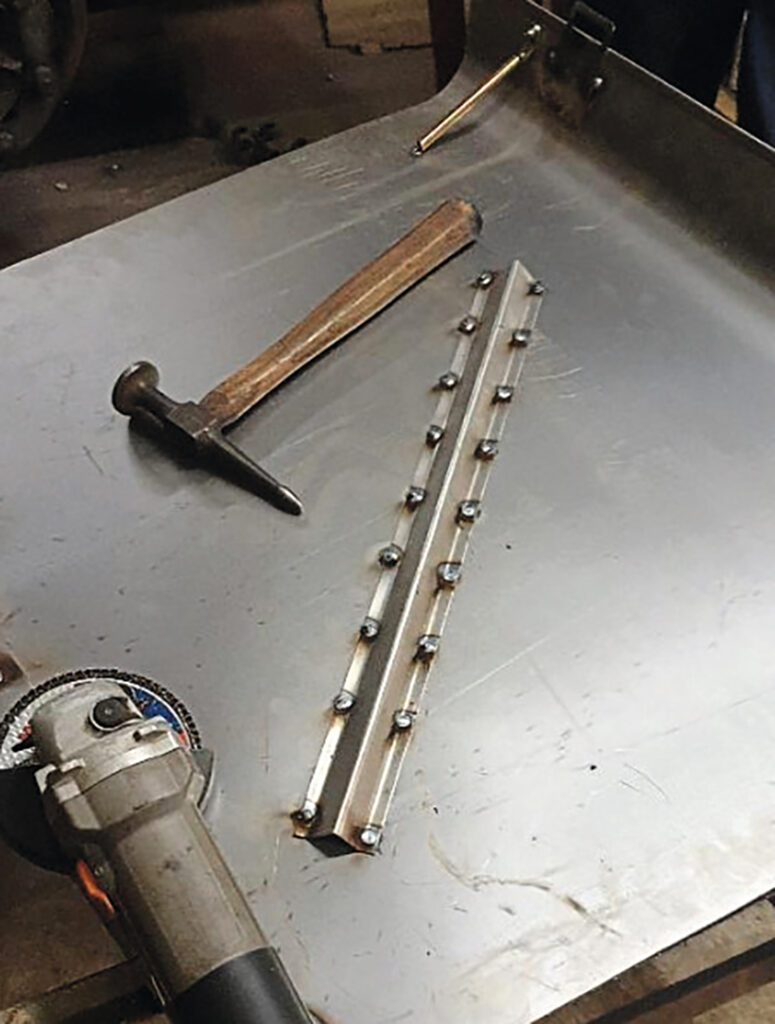
The bonnet top sections were among the panels which had to be remade from scratch.
From October 1941, after civilian vehicle production had ceased for more than a year, the Government finally granted permission for Bedford to start producing vehicles for civilian operators in very limited numbers. This took place under the scrutiny of the Ministry of Supply, which regulated specification and production, and the Ministry of War Transport, which oversaw allocation. It was for this purpose that the five-ton OW range appeared, comprising the OWST short-wheelbase tipper, OWLD long-wheelbase dropside, OWLE long-wheelbase platform lorry and OWB bus. Apart from the OWB, all were produced with the snub-nose fronts and Solex carburetters, but civilian wheels.
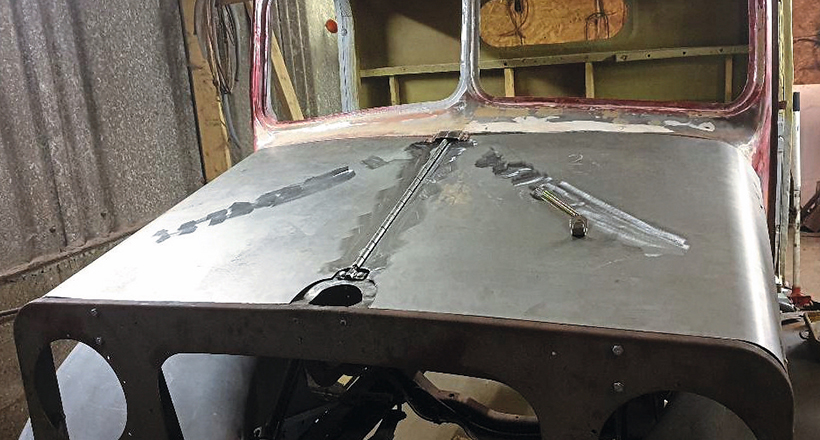
You would never know the metalwork isn’t original.
The OWL used the same 157-inch wheelbase as the OL of 1939, with 32 by 6in front tyres and twin 34 by 7in rear tyres. Remarkably, Bedford used the same engine and gearbox across a huge span of vehicles, from 15cwt MWs to the six-ton OXC tractor units. The Alex Taub-designed WD-type six-cylinder was a petrol engine of 3518cc (85.72 by 101.6mm bore and stroke), rated at 27.34hp and producing 72bhp at 3000rpm. It had been introduced with the bullnose radiators in 1938.
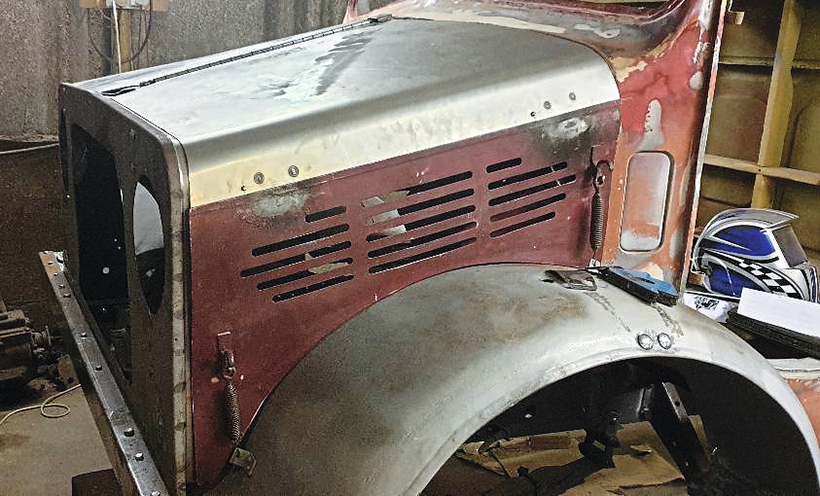
A second-hand replacement front panel was found.
Bedford records show that Bill’s lorry was produced in the third week of November 1944 and issued with the Norwich registration BVG 551. During a time of war, there can be nothing better for keeping morale up than the ready availability of good draught beer, and it found an appreciative owner in a Norwich brewery, Youngs, Crawshay & Youngs, with which it served as a flatbed until 1951, when it was bought by a farmer, Tom Cook, who ran Uplands Farm in Carlton Colville, near Lowestoft, and used it for transporting sugar beet, corn, and peas.
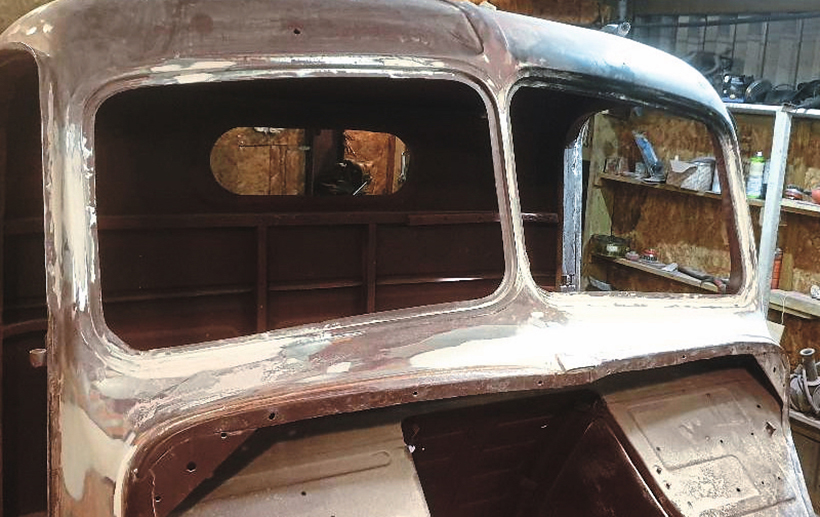
Angelo’s work was meticulous, and included rolling a new gutter around the doors.
With Cook, it was rebuilt as a dropside tipper with an Anthony hydraulic ram, which is a particularly large and impressive-looking piece of equipment on account of the oil bath being built in unit with the ram. It was not repainted, however, and remained in its original black with the brewery’s sign-writing on the doors. It was evidently worked hard as it received a replacement engine at some stage, the present unit dating from 1949.

The door bottoms had rotted away completely.
Tom Cook’s son, Ken, remembers growing up on Uplands Farm well: “I was milking cows at six, and at eight years old I was left alone with a Fordson tractor after being taken round the field twice.” Once he became a young man, he had to work hard for his living, labouring for 70 hours a week. Going out on deliveries must have come as something of a relief from the manual work. “I passed my test at 17 in a 30cwt. Bedford. We had three lorries on the farm, all Bedfords, and five tractors.”

Angelo did an excellent job of blending in the new metal.
In 1957, he turned 21 – old enough to drive the five-ton OWL – and so covered many miles taking produce from farm to factory. The regular runs to the British Sugar factory in Bury St. Edmunds were about 100 miles in total. Ken remembers driving it for five years before it was forced into retirement by new regulations which required lorries in excess of a particular payload to have at least 10-wheel studs, whereas the OWL only had eight. Thus, from 1962, it was placed into a shed for storage, where it would steadily deteriorate over 57 years, and succeeded by a Bedford S-type.

Angelo’s attention to detail even included recreating the raised pattern on the inside of the doors.
Says Bill, “I think what saved it was that the farmer had mounted a diesel storage tank on the back for his tractors. It had sloshed around everywhere and that might have saved the chassis, although it didn’t save the cab. It didn’t do a lot for the woodwork, either.”

Every panel forward of the cab had to be replaced.
When Bill bought it, boards had been added to the sides of the body which made it two feet taller than it is now, but they rendered it too high for his storage unit. A mileage of 5,586 miles was recorded on the original speedometer, which was likely genuine for the replacement engine.
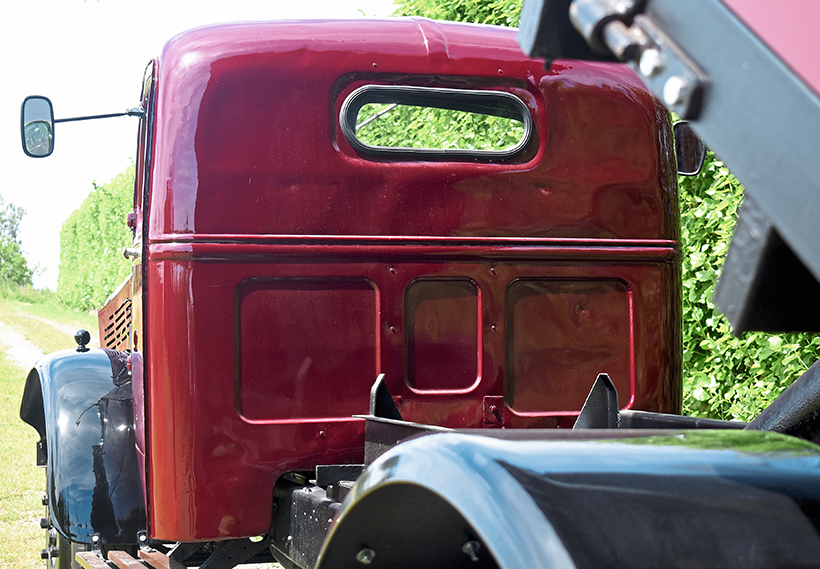
The cab had started to split in two, and was only rescued after a copious amount of welding.
Bill’s appraisal leaves us with no doubt as to what years of decay had done to the cab: “It was really rough. It needed new front wings and a new bonnet. The door bottoms had all gone. The cab was in a hell of a state.”
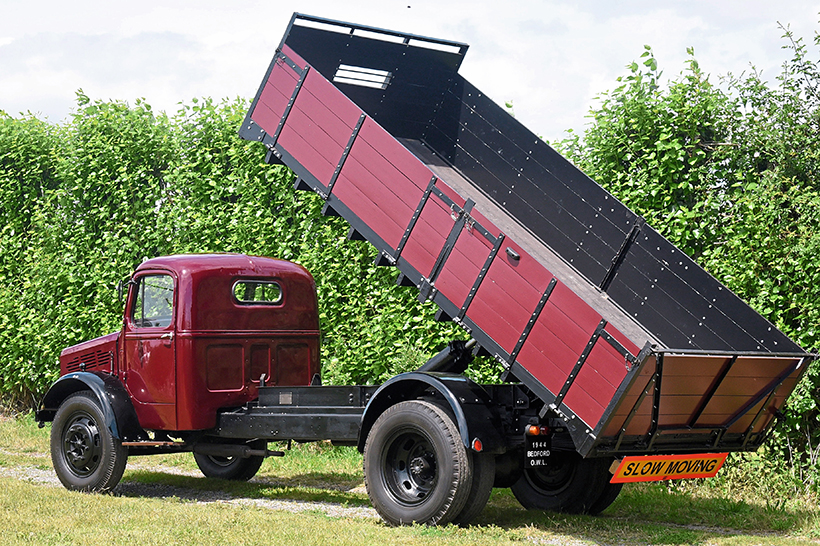
Cook was responsible for its conversion from a flatbed to a tipper lorry.
The cabs were made in two pieces and joined in the middle, but rust had set in all around the seams and had split it more or less back into two parts. All the woodwork was rotten, too, from the frame of the cab to virtually the entirety of the tipper body. The chassis, fortunately, had been very well protected by all the diesel spilt over it, and did not require any major work.

This rare Bedford OWL was restored from 2019 to 2022.
The engine was partially seized, but turned out better than might have been expected. “What I did,” Bill relates, “was put Redex down the cylinders and left them for a bit, and that freed the engine. I pulled the pistons out and had the big-ends off, but I didn’t renew anything. At that time, the bill was mounting for other things…”
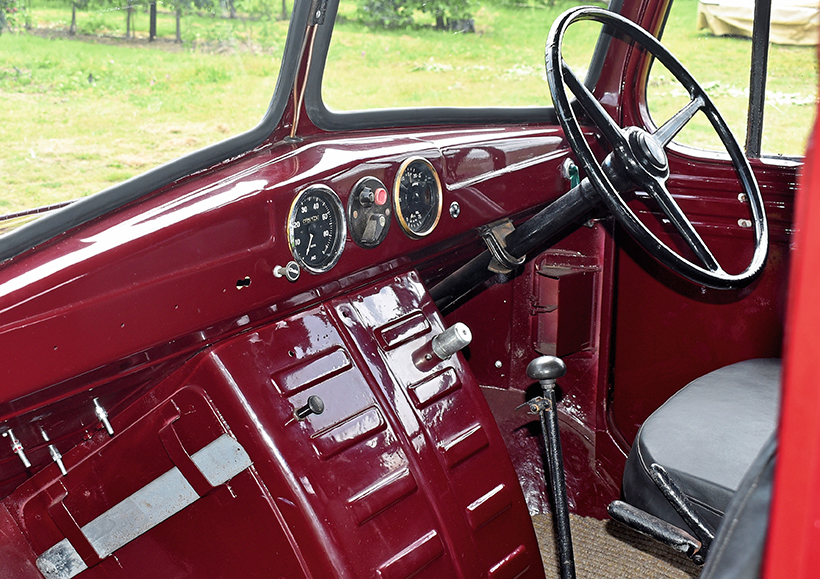
Bedford’s pressed-steel cabs were an advanced feature when they appeared in 1939.
It was fortunate that the seizure of the engine had not resulted in any damage, but a comprehensive overhaul of the chassis was keeping Bill busy. It had been stripped back to the bare frame to be shot-blasted and painted, but parts such as kingpins, brake shoes, shackle pins and bushes were all due for replacement. He stripped the springs down and found them entirely serviceable, so just cleaned and greased them before refitting them. The rear tyres were good enough to retain, but the front ones had to be replaced, at a total cost of £600 for the pair. A glance inside the gearbox and back axle showed that they were perfectly sound.
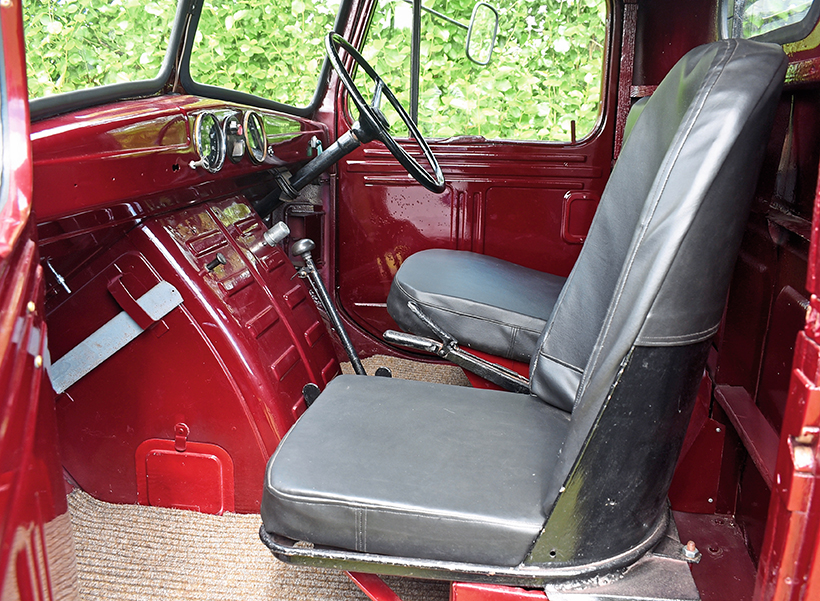
One of Bill’s friends assisted by upholstering the seats.
Turning to the cab, Bill first of all sent it away to be grit-blasted: “There wasn’t much left of it when it came back…” The restoration thus became a rather repetitive process of cutting and welding and cutting and welding, but in this Bill was valuably assisted by a young helper, Angelo Esposito. “He’s an HGV mechanic, not a panel-beater, but he does a lot of chassis welding for MoTs. He’s got a hell of a lot of patience. The whole cab had to be welded, it needed pieces in the floor and everything.”
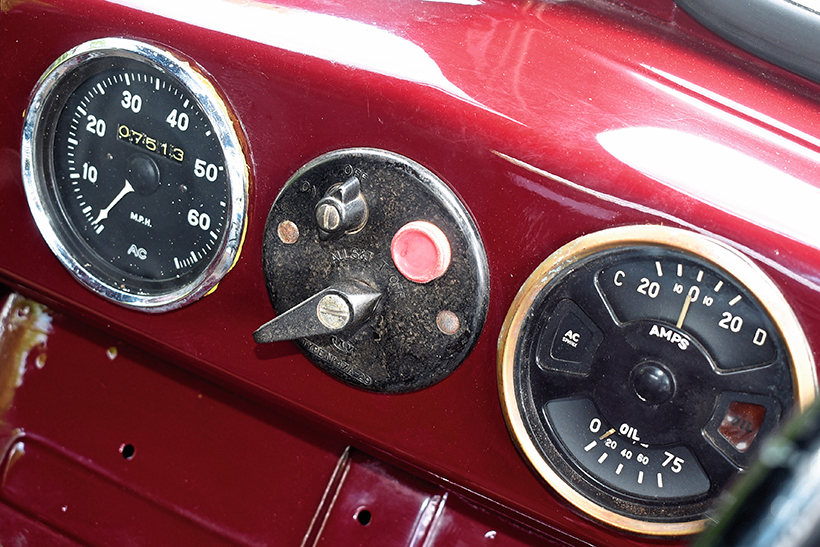
The facia is Spartan but contains a speedometer, ammeter and oil pressure gauge.
Despite its holes, the cab was about the only piece of bodywork which could actually be reused. The wings, the front panel and the bonnet side panels were so badly rusted that second-hand replacements had to be sourced. Most things turned up after long hours scouring the internet and magazines. “The wings I bought in Grantham. I thought, ‘Nobody else is going to get them,’ because they’re very, very rare.”

The large Anthony hydraulic ram is an impressive piece of engineering just by itself.
Anything that couldn’t be sourced, such as the bonnet and bumper, had to be made from scratch. “For the bonnet hinge, I had to use a six-foot hinge and cut it down. It was the only way I could get one thick enough. The brand-new bumper was made by a fabrication shop in Strood, only because we didn’t have a bender big enough to bend it. There shouldn’t be a window in the back of the cab, there should be a sliding hatch, but it was much easier to put a window in.”

The gearbox and rear axle did not require anything in the way of restoration.
It was in some of the finishing details that Angelo really proved his worth. He took on some of the most complicated bodywork jobs, including rolling a new gutter over and around the doors, and meticulously recreating the pattern on the inside of the doors, where the bottoms had been replaced with completely new metal. Interior fittings such as the speedometer and vacuum wiper motor had long since passed their expiry date, so Bill also had to search for some appropriate second-hand units. A brand-new wiring harness went in, with Bill making up some indicator units: “I don’t think I’d put it on the road these days without indicators.”
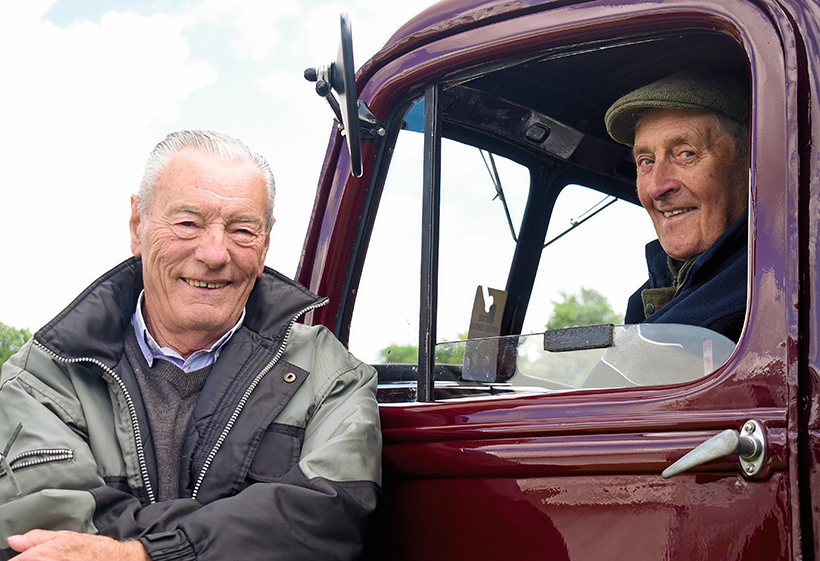
At the 2024 Kent County Show, Bill reunited the lorry with Ken Cook, who drove it in the 1950s and ’60s.
Most of what remained to be done, Bill was able to do himself. He constructed the new tipper body from scratch and painted the cab Imperial Maroon to match the OXC. It only remained to put some upholstery on the seats, which had originally been covered in a canvas-type fabric. Says Bill, “A friend of mine who keeps Model Ts is pretty good at making seats, so I got him to do the seats for this.” This time, a simple dark vinyl was used.
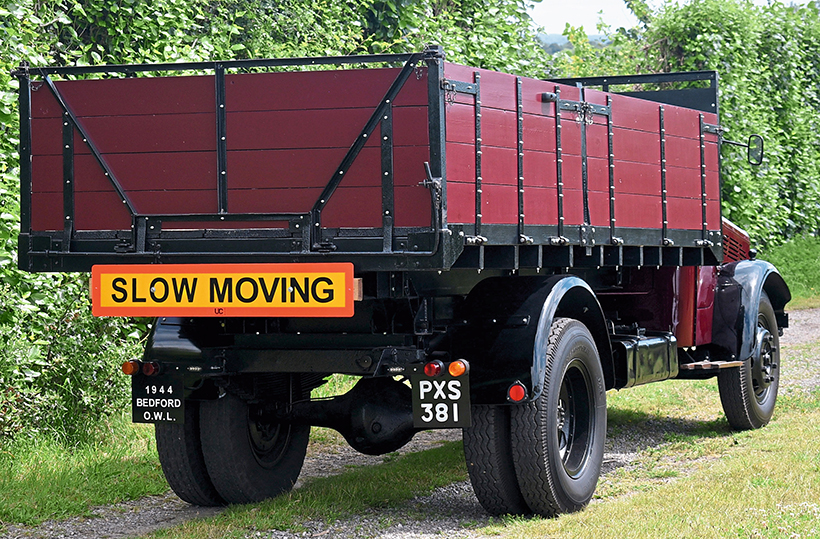
Originally a brewer’s lorry, Suffolk farmer Tom Cook bought it in 1951.
The project took about 2½ years, the OWL going back on the road in April 2022. It ran well straight away, without any teething problems, and in the time that’s passed Bill has taken it to a few local events, although he’s so far refrained from going further afield; it’s not the fastest thing on the road and the lighter OXC is preferred for longer-distance use.
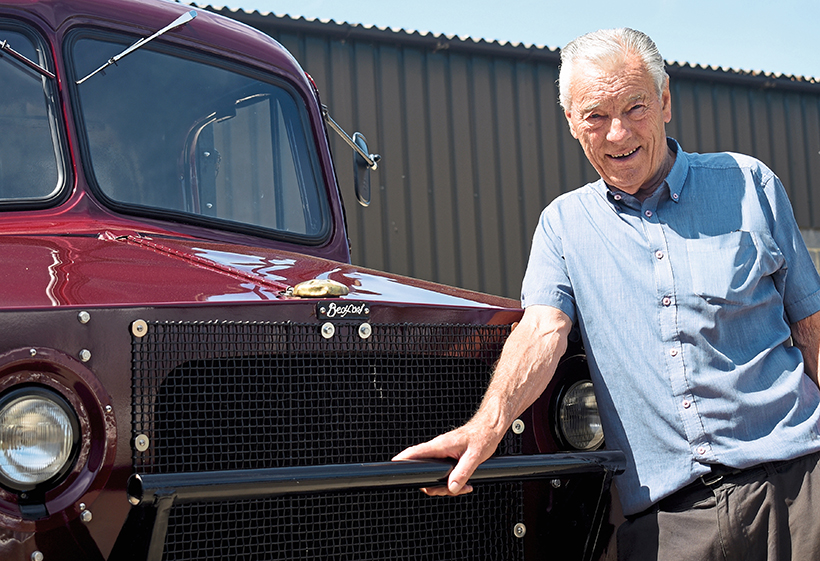
Bill Thorburn has made a superb job of the lorry’s restoration.
That isn’t to say that it doesn’t do its fair share of driving: “On the odd weekend I take it out and have a mad burst around the local roads. It performs well, or normally for what was expected then, when 30mph was your speed limit.”
It makes for some interesting comparisons with the OXC where the steering and ride comfort are concerned. “The OWL’s not so bumpy,” Bill remarks. “The other one’s a bumpy old thing, although it’s fine when the trailer’s on it.” The steering, of course, is very heavy. “That’s why power steering’s going on, although this one’s not too bad. It’s the OXC that’s a nightmare to reverse when it’s got a trailer on it. But the power steering’s for my granddaughter – at least, that’s what I tell people…”
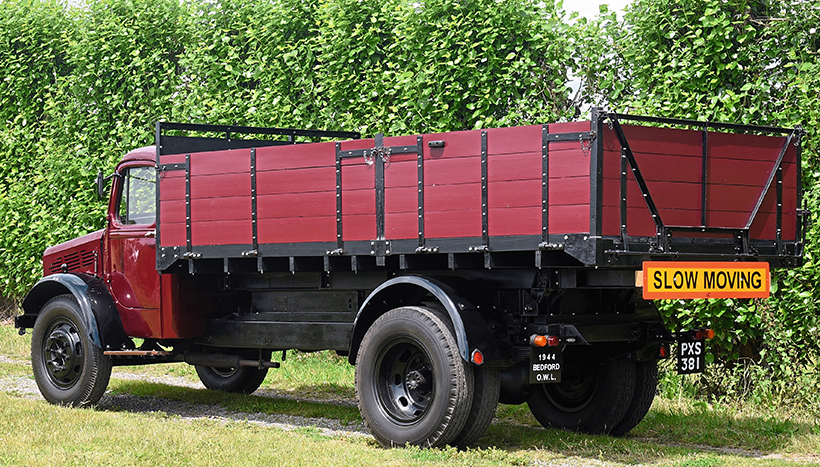
OWLs were produced to a wartime specification but for civilian use.
Indeed, while there is some consternation about interest among younger generations in our hobby, Bill has nothing to worry about. His granddaughter, a paramedic by day, is “very enthusiastic” about the old Bedfords, and the plan henceforth will be for the two of them to attend rallies together, he in the OXC and she in the OWL, so there ought to be plenty of opportunities for enthusiasts, in the south-east at least, to see these two rare Bedfords out together. In fact, this year’s Kent County Show was a particularly special occasion, for it was there that Bill reunited the OWL with Ken, just two weeks shy of his 88th birthday, who made the journey from Norfolk specially. Remembering the Bedford as a “very good” lorry, he was overcome with delight. “I can’t believe my eyes,” were his words, uttered through a broad smile. Bill’s efforts to save the old lorry, so richly endowed with history, have not been in vain.
This feature comes from a recent issue of Old Glory, and you can get a money-saving subscription to this magazine simply by clicking HERE
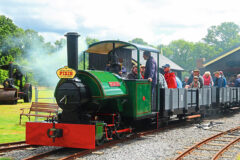
Previous Post
A restored 1919 industrial loco makes its debut
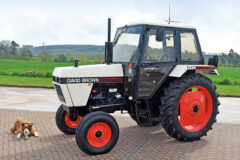
Next Post
Enthusiast’s 1970 David Brown 1294 tractor is simply superb!



